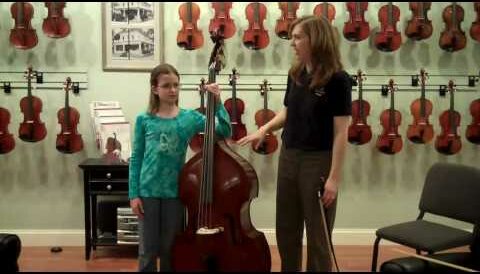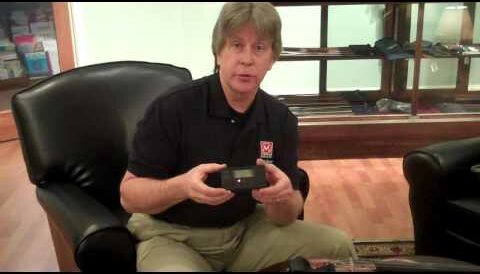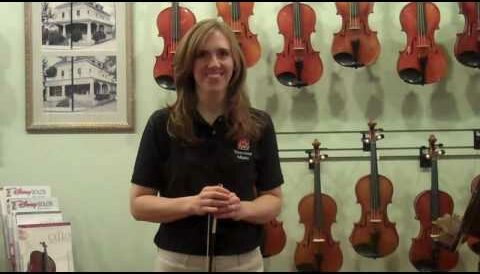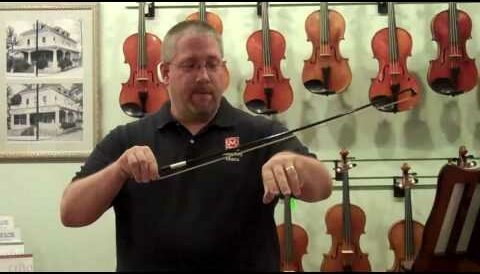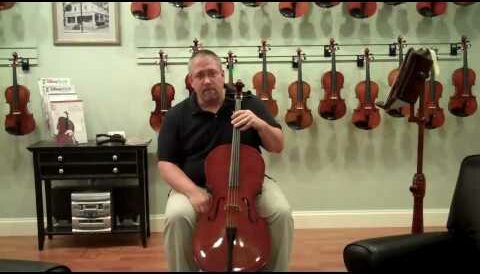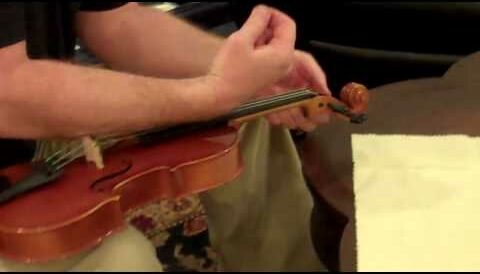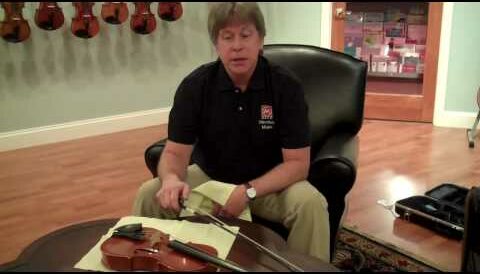Orchestral String FAQs
- How do I care for and maintain my string instrument?
-
Your instrument should always be stored at a comfortable room temperature and at a constant humidity level. If the humidity level is too low, you can add humidity by using humidifying systems for instruments such as Dampit, Planet Waves Humidipak, etc. Never store your instrument near a heating vent or radiator. Never leave your instrument in the car in extremely hot or cold weather. Remember, your instrument feels comfortable at the same temperatures you feel comfortable.
Wipe down the instrument after each use with a clean, soft cloth to remove rosin dust residue from the instrument. Periodic cleaning with Menchey Bowed String Gallery String Polish will help maintain the luster of the instrument. Never use alcohol or water. It will damage the varnish.
Instruments should be stored in the case or bag when not in use for maximum protection.
The bridge feet should line up with the inner notches of the F holes and the bridge itself should stand perpendicular to the top of the instrument. Tuning the strings tends to pull the bridge forward, so it is important to check the position of the bridge frequently. If let go, it can cause the bridge to warp or even break. To straighten the bridge, place your thumb and index fingers at the two top corners of the bridge and pull or push to adjust accordingly. Make sure the instrument is secure while doing this or ask your teacher for help.
Always refer any repairs to a qualified string luthier or repair technician.
- How do I care for and maintain my bow?
-
Avoid handling the bow hair with your fingers.
Do not tighten the bow too much. The stick of the bow should curve toward the hair even when the hair is tight.
Always loosen the hair after each use.
Wipe excess rosin off the wood part of the bow.
- How often should my bow be re-haired?
-
If you are practicing 1 hour a day at least 3-4 times a week, you should re-hair your bow every 6 months, otherwise every year.
- How do I choose the right strings for my instrument?
-
Selecting strings can be a confusing and expensive task. A basic understanding of strings and how they are made will help in making an informed choice. The string core is what primarily affects the sound of a string. Strings are typically made with one of the following core types; solid steel core, stranded steel core, synthetic core, gut core.
Solid steel core is relatively bright, has a clear sound and an easy bow response. Steel core strings have a quick break-in time and are stable and durable.
Stranded steel core has a warm clear sound, quick and easy bow response and also has a fast break-in time and is very stable and durable.
Synthetic core strings have a warmer richer sound than steel and is more durable than gut core strings.
- Gut core has the warmest sound and richest tone, but is slow to break in, less stable and the least durable of all the string core types. Gut core is recommended for advanced players only.
After the core material is selected then the wrap wire is selected. The wrap wire is used to add mass to the string to achieve the proper pitch and tension. Different metals are used for each string depending on the durability of the material and the weight. For example, a cello C string often will use tungsten because tungsten adds a lot of weight in a very small area. The smaller the string diameter, the faster the bow response.
Next, strings can come in various tensions, light, medium, heavy or some other adjective to describe tension. The lighter the string tension, the more dynamic range. The musician can play closer to the bridge and closer to the fingerboard to cover a larger dynamic range while playing. A heavy tension string will give a larger overall volume, however, it will be more limiting in dynamic range, it will be more difficult playing closer to the bridge or fingerboard. Medium tension is in between light and heavy and is always a good place to start. So first, decide what kind of sound you are looking for, then what kind of bow response you need and read the string packaging to find out what the string is made with to determine what kind of string will best suit your needs.
- How do I care for and maintain my strings?
-
It is good to wipe the rosin off the strings frequently with a clean dry cloth. It will help to give maximum playing life of the string. Strings should be replaced every 6 months to a year, violin and violas closer to 6 months, cello and basses approximately once a year. They may need to be changed more frequently if used more than 1 hour a day 3 – 4 times per week.
Tutorials & Additional Resources
Watch any of the videos to your left to learn more about sizing and instrument care tips. Subjects include:
- Sizing for String Bass
- Sizing for Cello
- Using a Pitch Pipe to Tune Your String Instrument
- Applying Rosin to Bow
- How to Tighten or Loosen Your Bow
- Adjusting a Cello or Bass Endpin
- How to Change a String on a Violin
- How to Wipe Down a Violin Bow
Additional Resources
Tutorials & Additional Resources
Watch any of the videos above to learn more about sizing and instrument care tips. Subjects include:
- Sizing for String Bass
- Sizing for Cello
- Using a Pitch Pipe to Tune Your String Instrument
- Applying Rosin to Bow
- How to Tighten or Loosen Your Bow
- Adjusting a Cello or Bass Endpin
- How to Change a String on a Violin
- How to Wipe Down a Violin Bow
Additional Resources
For more information or to schedule an appointment:
Menchey Orchestral String Gallery
1185 High Street
Hanover, PA 17331
Sandy Neill, String Specialist
Phone: 888-636-2439 x 236 or
email Sandy.
